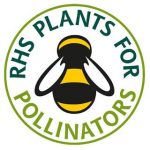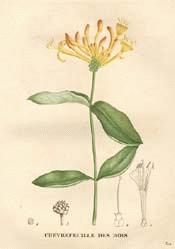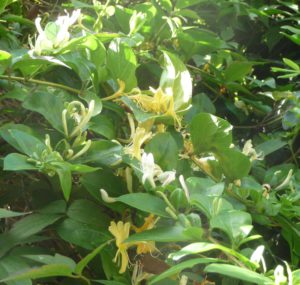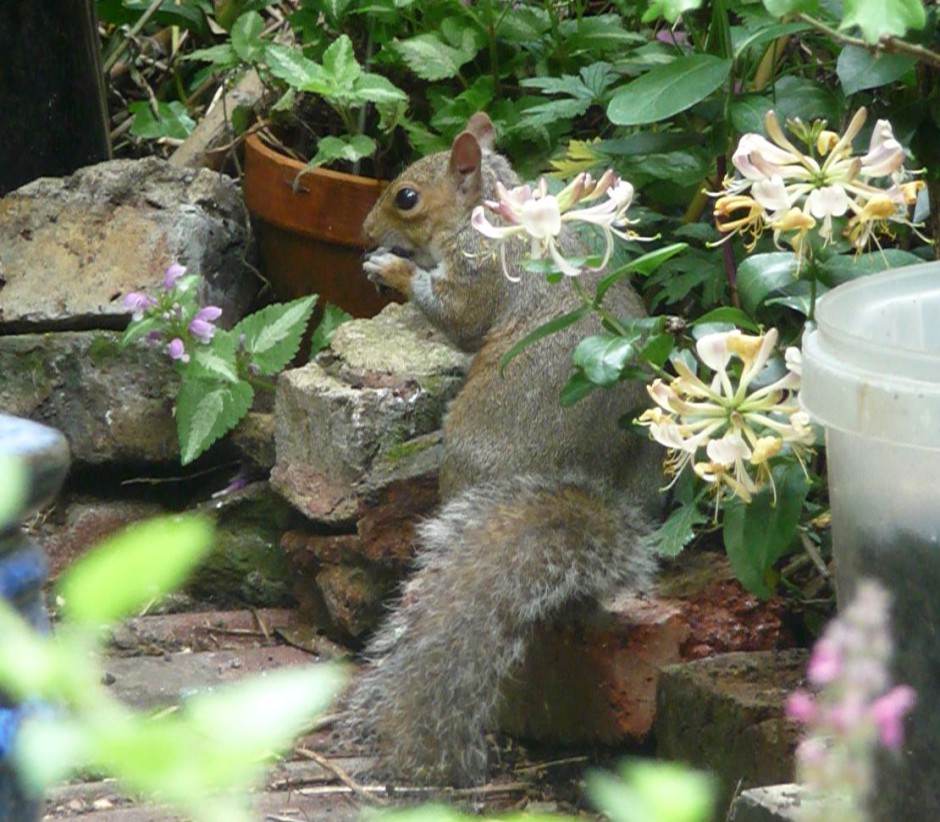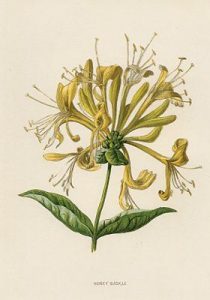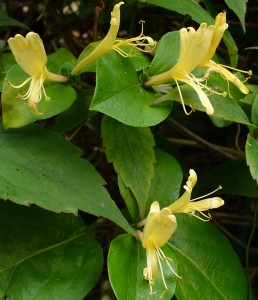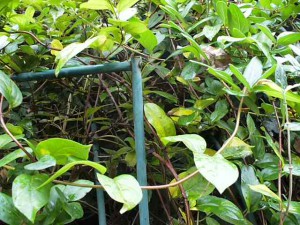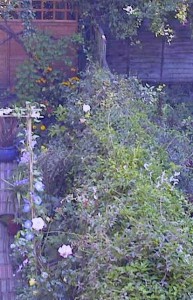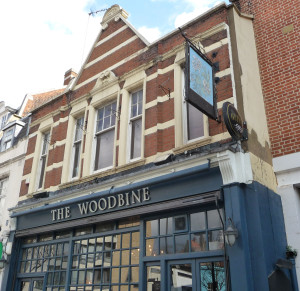HONEYSUCKLE (Lonicera periclymenum)
Europe, N Africa, Turkey and the Caucasus
Our native Honeysuckle, with its fragrant, creamy YELLOW flowers, spills over the walls of front gardens in this neighbourhood. When the season favours Lonicera periclymenum, every Honeysuckle is a mass of blooms inviting passersby to come closer & breathe in the perfume. Flowers appear from May/June to August, followed by red berries in autumn. These turn to black & are available for the birds but toxic to humans.
Bees’ Favourite
Honeysuckle is wildlife-friendly; its nectar attracts bumblebees & night-flying moths. Bumblebees whose tongues are too short may resort to biting a hole in the base of the flower tube to reach the nectar. Moths visiting the flowers include Convolvulus Hawk-moth, Privet Hawk-moth, Elephant Hawk-moth, Small Elephant Hawk-moth, Lime Hawk-moth, Shark, Lychnis, Silver Y & Puss Moth. When no insects visit the flower it may be self-pollinated.
The RHS & The Wildlife Trusts’ Wild About the Garden website has a list of the 30 best plants for all bumblebees, whatever the length of their tongues. Honeysuckle is among the top 30.
http://www.wildaboutgardens.org.uk/index.aspx
History and Folklore
“The sturdy stems of Honeysuckle have been used to make rope as far back as the Bronze Age, and in parts of Britain are still commonly made into bridles and harnesses for pack ponies. In Geoffrye Chaucer’s work, ‘wodebyne’ is a symbol of steadfastness in love and Shakespeare wrote of it in Act IV Scene i of A Midsummer Night’s Dream: “Sleep thou, and I will wind thee in my arms… so doth the woodbine the sweet honeysuckle Gently entwist;
The scent of Honeysuckle is said to clear the mind, stimulate psychic powers, sharpen intuition, encourage psychic dreams, sweeten any mood and stimulate generosity. A flower rubbed on the forehead is said to increase psychic abilities.”
The Witchipedia
It was believed that if honeysuckle grew around the entrance to a house it prevented a witch from entering. If it grows round your door it will bring good luck. If it grows well in your garden, you will be protected from evil. Bringing the flowers into the house will bring money with them. In Ireland Honeysuckle was believed to have a power against bad spirits, and it was used in a drink to cure the effects of the evil eye.
In the Victorian era, there was a ban on young girls bringing honeysuckle into the home because the heady fragrance of the flowers was believed to cause dreams that were far too risque for their sensibilities.
Flora: The Folklore and Traditions of the Irish Hedgerow http://irishhedgerows.weebly.com/flora.html
In the Victorian Language of Flowers, Honeysuckle was given the qualities of ‘generous and devoted affection.’
Medicinal
The black berries of Honeysuckle are highly toxic. The leaves have anti-inflammatory properties. Flowers & flower buds are used in various infusions & tinctures to treat coughs, catarrh, asthma, headaches & food poisoning. The leaves & flowers are rich in salicylic acid & are used to relieve headaches, colds, flu, fever, aches, pains, arthritis and rheumatism.
silentowl: Folklore of the Hedgerow Part Ten
http://amayodruid.blogspot.co.uk/2011/04/folklore-of-hedgerow-part-ten.html
Gerard says: ‘The Honeysuckle is “neither cold nor binding, but hot and attenuating or making thin”‘. He quotes Dioscorides as saying that: The ripe seed gathered and dried in the shadow and drunk for four days together, doth waste and consume away the hardness of the spleen and removeth wearisomeness, helpeth the shortness and difficulty of breathing, cureth the hicket (hiccough) etc. A syrup made of the flowers is good to be drunk against diseases of the lungs and spleen.’ He also recommends it for sores in the alimentary canal.
( Gerard, 1545-1612. )
“The herbage of the true Honeysuckles is a favourite food of goats, hence the Latin name Caprifolium (Goats’ Leaf), the French (Chevre-feuille), German (Geisblatt), and Italian (Capri-foglio), all signifying the same. The berries have been used as food for chickens.
Our native Honeysuckle has expectorant and laxative qualities. The flowers in the form of syrup have been used for diseases of the respiratory organs and in asthma and the leaves as decoction in diseases of the liver and spleen.” It was also considered a good ingredient in gargles.”
Maud Grieve, A Modern Herbal, 1931.
Used as an antiseptic, Lonicera periclymenum ‘ in small doses, is a useful addition to cough mixtures.’
RHS Encyclopedia of Herbs and Their Uses, Demi Bown
Other names: Capri-foglio (Italian), Chevre-feuille (French), Dutch Honeysuckle, Evening Pride, Feithleann, Geisblatt (German), Irish vine, Fairy trumpets, Goat’s Leaf, Gramophone Horns, Honey Bind, Kettle Smocks, Lamps of Scent, Sweet suckle, Trumpet flowers, Woodbine.
The native Honeysuckle, also known as Woodbine, is enjoyed in the countryside now as it has been for centuries:
‘Oh how sweete and pleasant is Woodbinde, in Woodes or Arbours, after a tender soft rayne, and how friendly doth this herbe if I may so name it, imbrace the bodies, armes, and braunches of trees wyth his long winding stalkes and tender leaves, opening or spreading forth his sweete Lillies, like ladies fingers, among the thornes or bushes.’
Bulwarke of defence against all sicknesse, soareness, and woundes that doe dayly assault mankinde, gathered and practised by William Bullein, Doctor of Physicke, 1562, London.
GREEN MAGIC – Flowers, Plants and Herbs in Lore and Legend
Lesley Gordon, Ebury Press, Webb & Bower Ltd, Exeter.


